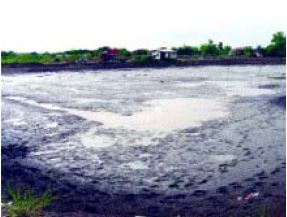AERATION
Most prawn farms use water exchange to keep dissolved oxygen levels high, as well as curing other water quality problems. When the original FAO manual on freshwater prawn farming was written in 1982 it was pointed out that the dissolved oxygen level of incoming water can be enhanced if ripples (Figure 50) are built into gravity inflow channels and water is injected into the ponds above water level (Figure 54).
It was also noted that permanent aeration equipment was not normally provided for many freshwater prawn grow-out ponds but that equipment for emergency aeration was useful in times of oxygen depletion (perhaps caused by an algal crash).
Figure 58
This freshwater prawn pond has just been totally drained (Thailand)

SOURCE: HASSANAI KONGKEO
However, since that time, aeration has become more commonplace in freshwater prawn farming because the higher stocking densities that are used in some grow-out systems and nurseries increase oxygen demand.
Paddlewheels (Figure 62) are the most efficient method of increasing dissolved oxygen levels in pond water (Table 15). Recently, long shaft engine-run paddlewheel aerators have been developed, which can be operated in remote areas far from power supplies (Figures 63 and 64). Aerators are needed to ensure the water quality necessary for increased productivity (for which maximum growth and survival rates are required) and emergency use, especially after partial harvesting. According to Boyd and Zimmermann (2000), aeration is valuable not only to maintain dissolved oxygen levels sufficiently high at night time (when they are naturally low) but also in the daytime, when they can become low at the pond bottom, where most prawns dwell. These authors noted that the provision of supplementary aeration equivalent to 1 horsepower could increase the productivity of a pond by about 400-500 kg/ha (this observation is based on experience with fish and marine shrimp and has not yet been quantified for freshwater prawns).
The selection of aeration equipment is discussed in another FAO manual (FAO 1996).